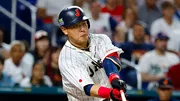
USA Today via Reuters
Feb 19, 2024; Port St. Lucie, FL, USA; New York Mets starting pitcher Kodai Senga (34) warms-up during workouts at spring training. Mandatory Credit: Jim Rassol-USA TODAY Sports

USA Today via Reuters
Feb 19, 2024; Port St. Lucie, FL, USA; New York Mets starting pitcher Kodai Senga (34) warms-up during workouts at spring training. Mandatory Credit: Jim Rassol-USA TODAY Sports
Baseball rarely hands out sympathy cards, and the Mets should know better by now. Just when the Wild Card picture starts to look manageable, reality finds a way to throw a forkball. Kodai Senga, the man meant to steady the rotation, has instead become the question mark scribbled in bold. For all their hot streak chatter, the Mets are learning how quickly stability can feel like an illusion.
Watch What’s Trending Now!
The New York Mets had one of the best pitchers in the league in Kodai Senga, and then the dreaded hamstring injury happened. And ever since Senga came back from it, he has not been the same. Nobody knows what the reason is, but MLB insider Mark C. Healey thinks that Senga is hiding more than what we are seeing.
In a recent post, Healey said, “I’m not a pitching guru by any stretch, but it seems to me that Senga’s struggles could be related to his legs. IMO, he’s either not fully recovered or doesn’t trust his hamstring enough to deliver his pitches properly. #Mets need him, so they need to figure it out.“
ADVERTISEMENT
Kodai Senga’s season has been a winding road of brilliance, frustration, and now urgent concern. Before his injury, he was the anchor of the Mets’ rotation, carrying a 1.47 ERA. That dominance was shattered when a right hamstring strain forced him to the injured list in June. The Mets survived the blow, but losing their ace while the Wild Card tightened left scars not easily erased.
Since returning, Senga has not resembled the intimidating presence that baffled hitters earlier in the year. He has failed to record a win across his last eight starts. Even worse, he has not completed six innings in any outing since rejoining the rotation. With a bloated 5.40 ERA since then, command issues and diminished sharpness have been glaring red flags.
I’m not a pitching guru by any stretch, but it seems to me that Senga’s struggles could be related to his legs. IMO he’s either not fully recovered or doesn’t trust his hamstring enough to deliver his pitches properly. #Mets need him, so they need to figure it out
— Mark C. Healey (@MarkCHealey) August 26, 2025
ADVERTISEMENT
The struggles have magnified further after the All-Star break, where his ERA ballooned to an ugly 6.10. Over 31 innings in the second half, he’s struck out 29 but walked 20. That ratio exposes his inability to attack hitters with the same confidence as earlier. When your ace is laboring through four innings on 93 pitches, the warning sirens blare loudly.
The timing could not be worse, as the Mets cling to playoff hopes in a fierce race. The Cincinnati Reds sit only 2.5 games back, leaving no room for wasted starts or short outings. A fully fit, dominant Senga is the difference between a postseason berth and another October collapse. For the Mets, the Wild Card hinges less on fate and more on Senga’s fragile form.
ADVERTISEMENT
The Mets can talk about depth, bullpen grit, and timely hitting all they want, but without Kodai Senga at full strength, it’s all window dressing. An ace isn’t supposed to be a maybe, and right now, Senga looks more like a question than an answer. The Wild Card race doesn’t reward excuses or patience—it rewards results. If the Mets want October relevance, their so-called ace had better start pitching like one.
Kodai Senga is not the only one who is struggling in the Mets’ pitching department
The Mets built their season around arms that were supposed to silence bats, but lately, the only thing quiet is the optimism. Kodai Senga’s post-injury comeback has been anything but smooth, leaving New York scrambling for answers. And while fans might wish his struggles were an isolated hiccup, the reality is harsher—Senga isn’t alone, and the Mets’ pitching woes are spreading faster than they can patch them.
ADVERTISEMENT
Reed Garrett has quietly been one of the Mets’ bullpen success stories since last summer, but the narrative has shifted dramatically in recent weeks. Once dependable in almost every situation, Garrett suddenly began to unravel as his outings became shorter and shakier. Over his last five appearances, he surrendered eight earned runs in just 4 2/3 innings. That disastrous stretch ballooned his ERA from a sharp 2.45 to a far less inspiring 3.61.
The Mets revealed Garrett’s struggles weren’t simply poor execution but were tied to physical discomfort and recovery issues. Manager Carlos Mendoza explained the right-hander had difficulty bouncing back between outings, prompting medical attention. An MRI brought relief, showing no ligament damage and only inflammation in the elbow joint. With that result, the team placed him on the 15-day injured list, prescribing rest, a cortisone shot, and a reset.
Top Stories
Blue Jays’ Bo Bichette Ambitions Dwindle as Red Sox’s Alex Bregman Backup Plan Confirmed

Yankees’ Cody Bellinger Hopes Fade Fast as Phillies Plan Desperate Push Amid Kyle Schwarber Uncertainty, per Insider

Aaron Judge’s Public Appearance Alongside Shaq, Tom Brady & Wayne Gretzky Turns Embarrassing for the Yankees Captain

Blue Jays Clash With Red Sox Over 29-Year-Old Japanese Star as Mets Fall Behind, per Report

Who Is Jazz Chisholm Jr.’s Fiancée? Everything You Need to Know About Ahna Mac

While Garrett rests, the Mets have turned to left-hander José Castillo from Triple-A Syracuse for reinforcement. Castillo’s call-up underscores the value of depth in a bullpen already stretched thin by injuries. Garrett’s role had recently shifted to the crucial middle innings, especially with starters failing to pitch deep. His absence, combined with Kodai Senga’s rocky comeback, magnifies the Mets’ pitching turbulence during an already uneven stretch.
ADVERTISEMENT
The New York Mets didn’t plan for Kodai Senga and Reed Garrett to headline the injury report, but here we are. What once looked like a carefully balanced staff now resembles duct tape over leaking pipes. Castillo’s promotion is a patch, not a solution, and everyone in Queens knows it. Until Senga finds form and Garrett heals, the Mets’ so-called pitching depth looks more like wishful thinking than actual reality.
ADVERTISEMENT
ADVERTISEMENT
ADVERTISEMENT

